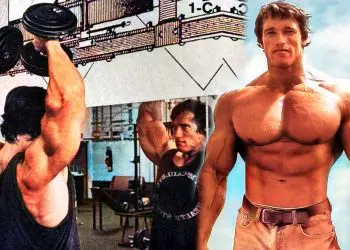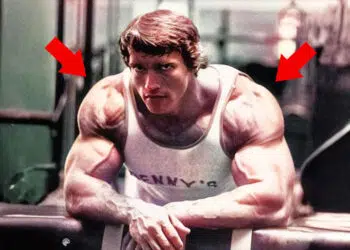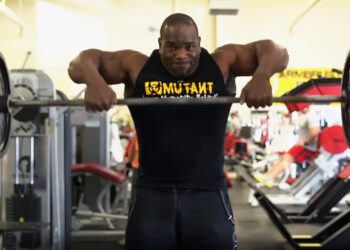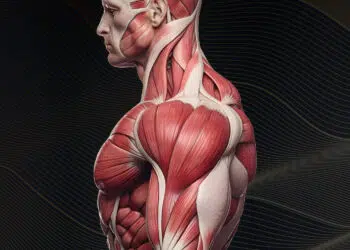There are a lot of exercises named after the person who invented them. In many cases, it was this namesake exercise that was at least partially responsible for the lifter’s success.
Good examples include:
- Arnold presses – Arnold Schwarzenegger
- Gironda neck press – Vince Gironda
- Hack squat – George Hackenschmidt
- Kroc rows – Janae Maria Kroc
- Pendlay rows – Glen Pendlay
- Saxon side bends – Arthur Saxon
- Scott curls – Larry Scott
- Yates rows – Dorian Yates
- Zercher squat – Ed Zercher
- Zottman curls – George Zottman
Now you can add another exercise to the list – the Bradford press.
Bradford presses, also known as the Bradford special, are named after 1960s Olympic weightlifter James (Jim) Bradford. Bradford was renowned for his massive shoulders and immense overhead pressing strength.
Because this exercise involves a behind-the-neck press, a lot of lifters avoid it, thinking that doing it will cause their shoulders to explode!
However, providing you have reasonable shoulder joint mobility, flexibility and stability, you should be able to do this exercise without catastrophic injury. In fact, it could be one of the best exercises for building massive, strong delts.
Level Up Your Fitness: Join our 💪 strong community in Fitness Volt Newsletter. Get daily inspiration, expert-backed workouts, nutrition tips, the latest in strength sports, and the support you need to reach your goals. Subscribe for free!
In this article, we reveal how to do the Bradford special and list seven of the best variations and alternatives.
Bradford Press – Muscles Worked
The Bradford press is a compound upper body pushing exercise performed while standing, which means it works virtually every muscle in your body, either directly or indirectly – even your legs. That said, the main muscles trained during this exercise are:
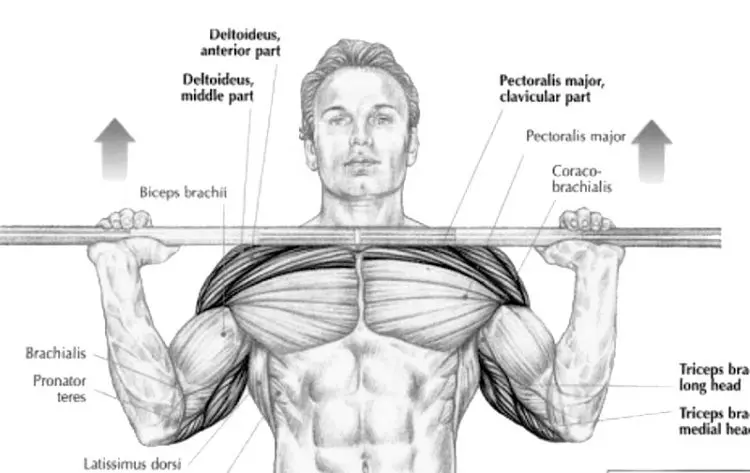
Deltoids – the deltoids are your shoulder muscles. There are three deltoid heads: anterior (front), medial (side/middle), and posterior (rear). All three deltoid heads are involved in Bradford presses, but anterior and medial are doing most of the work.
Triceps – located on the back of your upper arm, the triceps extend your elbows. The triceps are very active during the Bradford press as you never lock out your elbows, so they’re under constant tension.
Upper trapezius – the trapezius is a large kite-shaped muscle on your upper back. Like the deltoids, it’s made up of three sets of fibers: upper, middle, and lower. The Upper traps are responsible for keeping your shoulders elevated against the weight of the bar. In contrast, the middle traps help pull your shoulders back and together. The lower traps are not engaged much during Bradford presses.
Serratus anterior – this small but essential muscle helps keep your scapulae or shoulder blades flat against your rib cage. If you are very lean, it is visible between your upper ribs and has a serrated appearance, which is where it gets its name. In Bradford presses, the serratus anterior works to stabilize your shoulder girdle.
Core – core is the collective term for the muscles of your midsection. Consisting of the rectus abdominis, obliques, transverse abdominis, and erector spinae muscles, as well as the pelvic floor and diaphragm, these muscles contract inward to create intra-abdominal pressure, which supports your spine and helps maintain correct lumbar alignment.
How to Do Bradford Presses
Get more from the Bradford press while keeping your risk of injury to a minimum by following these guidelines:
- Stand with your feet roughly shoulder-width apart, knees slightly bent.
- Hold your barbell across the front of your shoulders using an overhand, slightly wider than shoulder-width grip. Your forearms should be vertical and your wrists straight. Pull your shoulders down and back and brace your core.
- Without using your legs, press the bar up until it’s roughly level with the top of your head.
- Push the bar toward the back of your head.
- Lower the bar down to lightly touch your lower neck/upper traps.
- Press the bar back up to the top of your head.
- Push the bar forward.
- Lower the bar down in front of your face and return to the starting position.
- That’s one rep – keep going!
Bradford Press Benefits
Not sure if the Bradford press is the right exercise for you? Consider these benefits and then decide!
A comprehensive upper body exercise – the Bradford press involves a lot of different muscle groups, including all three deltoid heads, the upper and middle trapezius, the triceps, and your core. As such, it’s a very time-efficient exercise and ideal for anyone looking to get the maximum training effect in the least amount of time.
A little weight goes a long way – Bradford presses keep your muscles under constant tension, which means lactic acid levels will rise very quickly, even if you aren’t using a great deal of weight. As such, this is a valuable exercise for home lifters who may not have access to heavy weights.
Good for shoulder mobility – taking the barbell behind your head will challenge and develop upper body flexibility and shoulder joint mobility. If you spend a lot of time in a protracted or hunched position, e.g., working at a computer, this exercise could help.
Variety – if you want bigger shoulders, you need to embrace overhead pressing. But, if you do the same old barbell or dumbbell shoulder press, your workouts could soon become dull. Adding the Bradford press to your exercise library means you have another exercise you can use to keep your workouts interesting and productive.
Bradford Press Drawbacks
While Bradford presses are a mostly beneficial exercise, there are also a few drawbacks to consider:
Risk of shoulder injury – while the Bradford press could help improve your upper body mobility and flexibility, if you have very stiff shoulders, doing it could actually lead to joint problems.
Long periods sitting at a desk, using keyboards and cellphones, and driving can lead to a hunched upper back and inwardly rotated upper arms. Trying to do Bradford presses when you’ve got poor posture is a recipe for shoulder pain.
Getting into the correct starting position can be tricky – the Bradford press starts with the bar in the front rack position. The easiest way to get into the proper starting position is to rest the bar on a squat rackset to shoulder height and take it from there.
If you don’t have access to a rack, you’ll need to learn how to power clean the bar up to your shoulders. Either way, getting the bar onto your shoulders may be difficult, especially if you are using heavy weights.
7 Bradford Press Alternatives
Bradford presses are a highly effective shoulder exercise, but that doesn’t mean you need to do it all the time. There are several alternatives you can use to keep your workouts productive and interesting:
1. Cuban press
Like the Bradford press, the Cuban press is an old-school total shoulder exercise. However, in this exercise, you’ll be combining an upright row with an overhead press. The Cuban press is a little more shoulder joint-friendly than the Bradford press. In fact, it was originally a pre/rehab exercise used by Cuban weightlifters.
Level Up Your Fitness: Join our 💪 strong community in Fitness Volt Newsletter. Get daily inspiration, expert-backed workouts, nutrition tips, the latest in strength sports, and the support you need to reach your goals. Subscribe for free!
How to do it:
- Hold a barbell in front of your hips using an overhand, slightly wider than shoulder-width grip. You can also use a thumbless or false grip if preferred. Stand with your feet about hip-width apart, knees slightly bent, core braced, and shoulders pulled down and back.
- Bend your elbows and upright row the barbell up to your sternum/lower chest. Your upper arms should be roughly parallel to the floor, elbows bent to 90 degrees.
- Without lowering your upper arms, externally rotate your shoulders and raise the bar up so it’s just above your head.
- Press the bar up to arms’ length.
- Lower the bar back to your shoulders and then rotate your arms outward and lower the back to your hips.
2. Z press
The Z press is a barbell overhead pressing exercise named after legendary Lithuanian strongman Žydrūnas Savickas, better known as Big Z.
Z presses involve pressing a barbell overhead while sitting on the floor with your legs extended in front of you. This eliminates your legs from the movement, so you have to rely entirely on your upper body to complete each rep.
The Z press was Big Z’s secret weapon and helped him become one of the best overhead pressers of all time. It worked for him, and it could work for you too!
How to do it:
- Sit on the floor with your legs straight and spread wide for balance. Adopt a tall posture. Hold a barbell across your shoulders as you would for regular overhead presses.
- Press the bar up and overhead with your core braced and without leaning forward or back.
- Lower the bar back to your shoulders and repeat.
- If you have tight hamstrings and cannot keep your legs out straight, sit on a 4 to 8-inch platform. This will reduce the angle of your hips and allow you to sit with straight knees.
Feeling feisty – try the Bradford Z press! Sit on the floor as you would for Z presses but then, instead of pressing the bar up to arms’ length, just lift it over your head and lower it to the back of your neck. This exercise really IS much harder than it sounds!
3. Arnold press
Named after bodybuilding legend Arnold Schwarzenegger, this exercise combines a sort-of seated pec fly with an overhead press to really hammer your deltoids.
Compared with regular dumbbell overhead presses, you probably won’t be able to use such heavy weights when doing the Arnold press. Still, the demanding movement will ensure that you still get a great workout from this exercise.
Some bodybuilders find the Arnold press a little shoulder un-friendly, so progress with care. Arnold presses can be done seated or standing and using dumbbells or kettlebells.
Learn how to overhead press like Arnold here.
4. Pike push-up
Pike push-ups are a convenient way to work your deltoids and triceps without equipment. As such, this is an excellent alternative to the Bradford press for anyone who works out at home or simply prefers bodyweight training.
How to do it:
- Adopt the push-up position with your arms straight, core tight, and hands slightly wider than shoulder-width apart.
- Push your hips back and up, and walk your hands toward your feet, so your body forms an inverted V or pile position.
- Bend your arms and lower your head down to the floor.
- Push back up and repeat.
- Use parallettes (push-up handels) to increase your range of motion or raise your feet to put more weight on your arms.
5. Behind-the-neck press
The behind-the-neck press is a very controversial exercise. And yet, despite many trainers all-but banning this exercise, it used to be a staple of old-school bodybuilding training.
Providing you have healthy, mobile joints, there is no real reason to fear the behind-the-neck press. It’s a useful overhead press variation. However, if behind the neck presses cause new shoulder pain or make existing shoulder pain worse, it’s best to skip this exercise.

How to do it:
- Stand with your feet roughly shoulder-width apart, knees slightly bent.
- Hold your barbell across the back of your shoulders using an overhand, slightly wider than shoulder-width grip. Pull your shoulders down and back and brace your core.
- Without using your legs, press the bar up and overhead to arms’ length.
- Lower the bar back down to your upper traps and repeat.
- Try to pull your shoulders back rather than push your head forward when doing this exercise.
6. Javelin press
The javelin press is a great way to do unilateral or single-limbed overhead presses with a barbell. Training one arm at a time will help you identify and fix left to right strength imbalances. This overhead press variation is also a very effective core exercise, as you’ll have to work extra hard to stabilize your spine.
How to do it:
- Set your barbell to shoulder height in a squat or power rack. Stand next to it, sideways on. Hold the bar with a neutral grip, with your palm facing inward. Make sure you grip the exact center of the bar. Brace your core and unrack the bar.
- Without leaning sideways, press the bar up and overhead. Grip it tightly to stop it from tilting or twisting.
- Lower the bar back to your shoulder and repeat.
- Rest and then change sides. Try and do the same number of reps with both arms.
7. Scrape the rack overhead press
The scrape the rack press increases deltoid activation. Instead of just pushing the bar upward, you also press it forward. This maximizes deltoid recruitment and tension, making it an excellent exercise for building bigger shoulders.
Be warned; this variation can chip the paint off your power rack, so don’t do it if your gym manager is touchy about that sort of thing. However, you can avoid this problem by putting some athletic tape on your barbell and the power rack you’re using.
How to do it:
- Seated or standing, set your barbell on J-hooks in a power rack at shoulder height. Grip the bar as normal.
- Pushing the bar against the vertical frame of the power rack, press it up and overhead. Make sure you push it forward against the rack as well as upward. Scrape that rack! Take care not to hyperextend your lumbar spine.
- Lower the bar back down and repeat.
Bradford Press – Wrapping Up
You probably won’t see many people doing Bradford presses, and that’s a shame – it’s an excellent exercise for building bigger, stronger, more mobile shoulders. However, because most people have an innate fear of doing behind-the-neck exercises, this is one pressing movement that is usually avoided.
If you’ve got healthy, mobile shoulders, give the Bradford press a try. Start light, maybe using just an empty barbell, as this exercise is a lot harder than it looks.
If you have tried Bradford presses and found them difficult, there is a good chance that your shoulders are immobile and tight. Take this as a sign that you need to start working on your upper body mobility and flexibility.
Interested in measuring your progress? Check out our strength standards for Push Ups, Zercher Squat, Arnold Press, and more.


